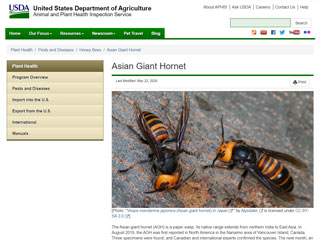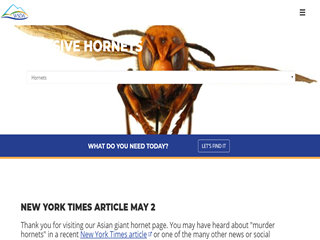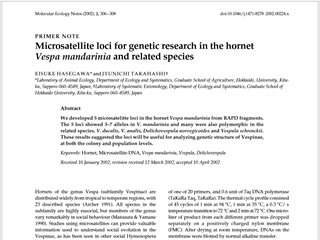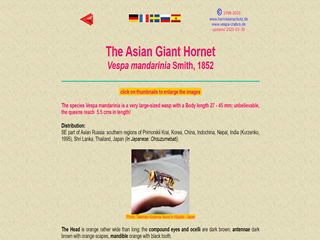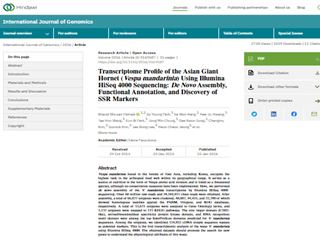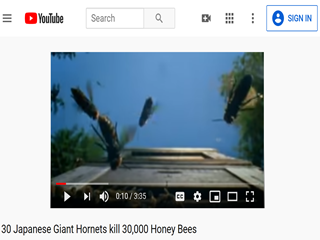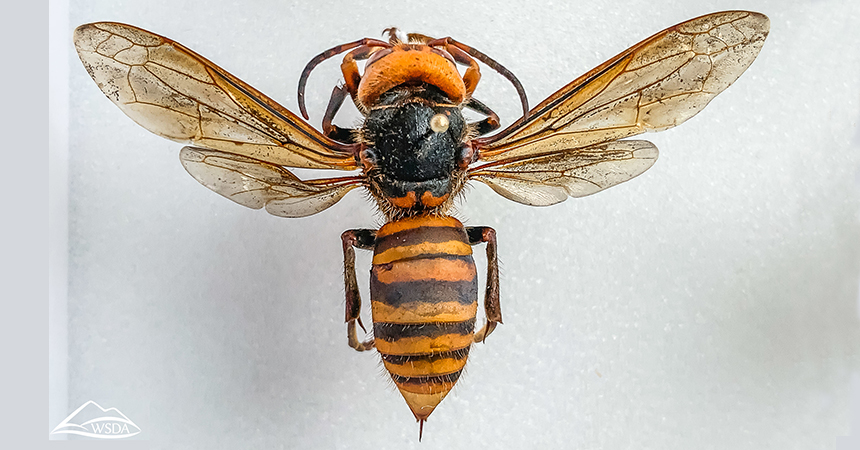
IDaids support identification of the Asian giant hornet
Vespa mandarinia, the Asian giant hornet (AGH), also known as the Japanese hornet or giant sparrow bee, is native to a region that extends from northern India to East Asia. This highly social wasp was first reported in North America in August 2019 in British Columbia, Canada. The report was confirmed by Canadian and international experts, and shortly after, an AGH nest in that area was found and eradicated. In December 2019, USDA APHIS confirmed the detection of a single AGH in Blaine, Washington, which is situated in the state’s northwest corner near the Canadian border, very close to the Canadian detections months earlier. Washington State University identified a second AGH specimen later the same month. There is currently no evidence that AGH is established anywhere in the United States, but the detections have sparked concern.
AGH is the world’s largest ‘true’ hornet (species in the genus Vespa), measuring 4 to 5 cm (about 1.5 to 2 inches) long. Adult hornets primarily eat fermented tree sap, but they also hunt other insects to feed to developing larvae. Adults don’t eat the insects themselves, as their narrow waists prevent them from digesting solids. People may fear the hornet's size, large mandibles, and long stingers, but the biggest threat from AGH is the potential ecological and economic damage they may cause if they become established.
Beekeepers should be aware of the hornets' predatory behavior towards honeybees, which typically happens in the late summer/early fall when the hornet colony is well established. A scout locates, or “hawks,” a target beehive and marks it with pheromones for her sisters to find. Then, in a coordinated effort, hornets rapidly attack and kill all the adult honeybees in the hive. During this phase, the hornets are not interested in the adult honeybees as food, so they discard their bodies. Once most of the adults have been killed, the hornets move on to occupy the hive. Hornets take the honeybee brood back to their own nest to feed developing males and future queens. During an attack, hornets fiercely defend the conquered beehive as if it’s their own. AGH may also attack other social bee and wasp nests in this way. This predatory behavior is why North American beekeepers are particularly concerned.
Unlike Japanese honeybees, Apis cerana, European honeybees lack defenses against the hornet. In Japan, the Asian honeybee defends its colonies against AGH either by patrolling around the colony and quickly killing any scout that comes near their nest. Asian honey bees have also developed a bee-balling behavior to defend against AGH. Specifically, the bees surround a hornet and use the heat from their vibrating wings to kill it.
Honeybees already face tremendous pressures that are causing unprecedented decline due to pests, parasites, pesticides, diseases, and colony collapse disorder. Beekepers, especially in Washington, should remain vigilant for this potential new threat.
In 2020, ITP received funding from the Plant Protection Act Plant Pest and Disease Management and Disaster Prevention Program to produce an identification tool for species of Vespa. ITP is working with the University of California, Davis and the American Museum of Natural History to produce a comprehensive website to support screening and identification of hornet species from around the world. Until that tool is available in late 2021, here is a set of IDaids that offer tips for identifying AGH and more as part of the effort to help protect our honeybees.
Visit Search IDaids to find identification resources for other pests and diseases that affect agriculture.
Asian Giant Hornet
United States Department of Agriculture (USDA)
This APHIS Plant Protection and Quarantine page offers images to differentiate AGH from potential lookalikes, links to report possible sightings, and more.
Asian Giant Hornet Response
Washington State Department of Agriculture (WSDA), United States of America
Includes enlargeable photos of the hornet and similar-looking species and a decimated hive in Washington, as well as an hour-long webinar Asian Giant Hornet in the Pacific Northwest (not “The World’s Biggest Wasp” video above it) covering the hornet’s morphology, biology, and life cycle, plus information on the current situation (as of May 2020).
Microsatellite loci for genetic research in the hornet Vespa mandarinia and related species
Molecular Ecology Notes, Blackwell Publishing
This paper reports on and discusses five microsatellite loci from RAPD fragments that may be used to distinguish Asian giant hornet specimens from related species.
The Diversity of Hornets in the Genus Vespa (Hymenoptera: Vespidae; Vespinae), Their Importance and Interceptions in the United States
Insect Systematics and Diversity, Oxford University Press, United Kingdom
This study covers distinguishing characteristics of the subfamily Vespinae from other Vespidae and includes an illustrated taxonomic key of the world’s Vespa species. It also discusses each valid species and lists their synonyms and distribution.
The Asian Giant Hornet: Vespa mandarinia Smith, 1852
Kosmeier, D., Billig, E., and Rickinger, T.
This page from a hobbyist website describes and illustrates the hornet's body parts and includes hive photos. Other topics of interest cover the hornet's biology.
Transcriptome Profile of the Asian Giant Hornet (Vespa mandarinia) Using Illumina HiSeq 4000 Sequencing: De Novo Assembly, Functional Annotation, and Discovery of SSR Markers
International Journal of Genomics, Hindawi, United Kingdom
The objectives of this study include isolating RNA from Asian giant hornet queens, constructing a cDNA library, and conducting whole-transcriptome sequencing. It summarizes transcriptome sequencing and presents novel microsatellite markers.
30 Japanese Giant Hornets Kill 30,000 Honey Bees
Insect Systematics and Diversity, Oxford University Press, United Kingdom
This YouTube clip from the BBC Natural World presentation of Budda, Bees and the Giant Hornet Queen captures the hornets in their slaughter and occupy phases.
